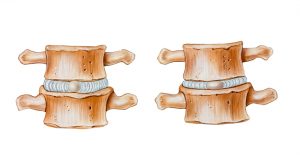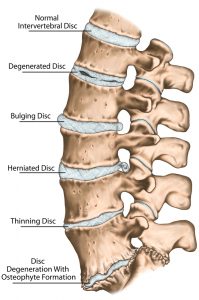Why do we lose height as we get older?
Posted by Phil Heler, MD on April 24, 2018In children, the discs are about 85% water. The discs begin to naturally lose hydration during the ageing process. Some estimates have the disc’s water content typically falling to 70% by the age of 70, but in some people the disc can lose hydration much more quickly.
WHY DO WE LOSE HEIGHT AS WE GET OLDER?
LOSS OF HEIGHT & DEGENERATIVE DISC DISEASE IN THE SPINE
People typically lose almost one-half inch (about 1 centimetre) every 10 years after age 40.
So why does this occur?
Disc degeneration is common in the neck (cervical spine) and lower back (lumbar spine). This is because these areas of the spine perform the most movement and undergo the most stress. Subsequently they are also most susceptible to disc degeneration (as these bear much of our weight).
Degenerative disc disease refers to symptoms caused by wear-and-tear on a spinal disc. In some cases, degenerative disc disease also causes weakness, numbness, and hot, shooting pains into the hip, groin and upper thigh (radicular pain) in the lower back or equivalent pain in the neck, shoulder and arm. Degenerative disc disease typically consists of a low-level chronic pain with intermittent episodes of more severe pain.
So why does this happen?
The discs are made of an inner toothpaste-like substance which is mainly comprised of water (nucleus pulposus) and an outer fibrous wall (anulus fibrosus) made of collagen.

The spongy intervertebral discs absorb shocks and pressure from the load of our bodies and squash as we lean or bend in any direction. They stop the vertebrae rubbing against each other (bone on bone) and they create a space between the vertebrae. This space is very important. Each vertebra has a hole in the middle and when the vertebrae are stacked on top of one another combine to form a tunnel or canal through which the spinal cord travels down from the brain.
In children, the discs are about 85% water. The discs begin to naturally lose hydration during the ageing process. Some estimates have the disc’s water content typically falling to 70% by the age of 70, but in some people the disc can lose hydration much more quickly.

As the disc loses hydration, it offers less cushioning and becomes more prone to cracks and tears. The disc is not able to truly repair itself because it does not have a direct blood supply. As such, a tear in the disc either will not heal or will develop weaker scar tissue that has potential to break again. At the same time as the disc both loses moisture and structural integrity it will protrude and bulge and can press on nearly nerves.
Our new IDD Therapy programme is effective in treating trapped nerves, is non-invasive (unlike surgery) and is pain free. IDD Therapy bridges the gap between what manual therapy cannot achieve and surgery. This therapy is the fastest growing therapy for trapped nerves and degenerative disc issues in the UK.